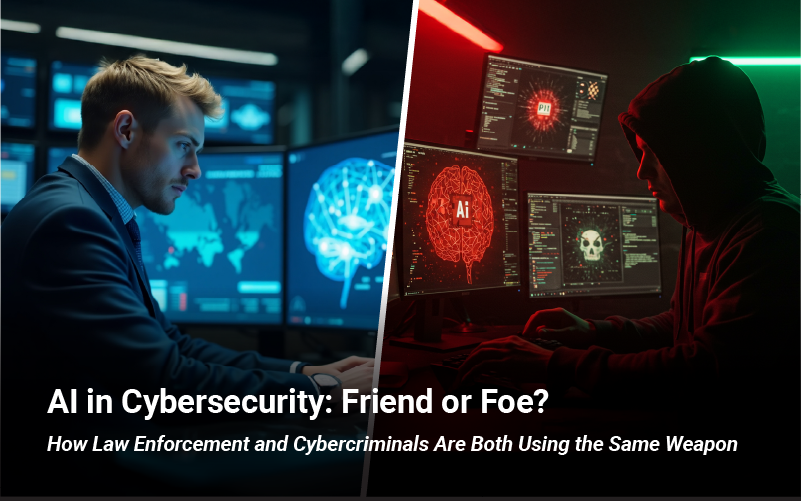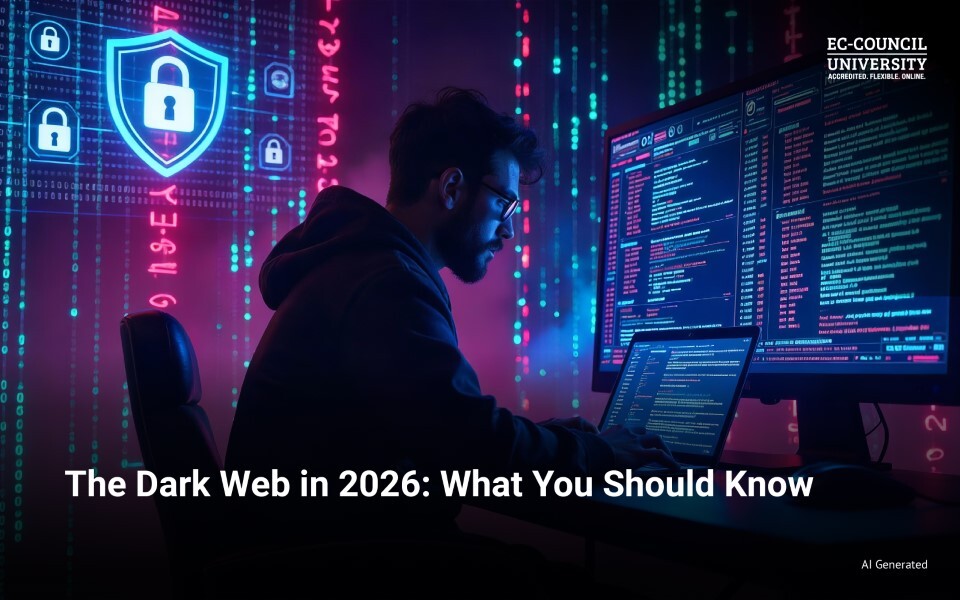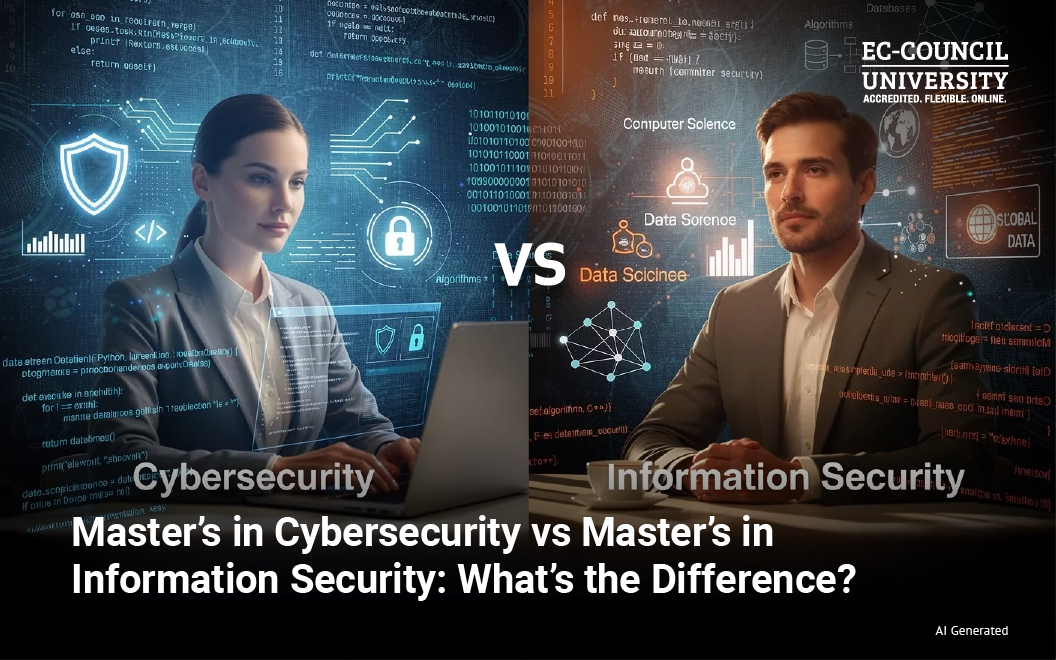How Law Enforcement and Cybercriminals Are Both Using the Same Weapon
Cybersecurity is no longer a game of defence and attack — it’s gotten much more complicated, and Artificial Intelligence (AI) is leading the way. While AI’s role in helping malicious actors carry out cybercrimes like creating manipulative deepfake videos, generating targeted phishing campaigns, and automating cyberattacks at scale is rapidly increasing, it’s also being used by law enforcement agencies to analyze data, monitor and prevent threats, and solve crimes faster than ever before. The evolving implementations of AI in cybersecurity and cybercrime show us that it’s no longer a one-sided advantage. AI is strengthening cybersecurity systems and simultaneously providing cybercriminals with innovative and powerful ways to bypass them.
This article gives you a closer look at how AI empowers both defenders and attackers, and how the dual use of AI technology is reshaping the future of cybersecurity.
AI as a Partner: Enhancing Cyber Defence and Law Enforcement
Real-Time Threat Detection
New threats develop too rapidly for legacy, rule-based security systems to keep pace. AI-driven tools, especially those based on machine learning, can process vast amounts of data to identify abnormal patterns, suspicious activity, and even zero-day vulnerabilities. Solutions such as IBM QRadar, Splunk, and Darktrace utilize AI to detect real-time threats, drastically reducing detection and response time. This advanced warning enables security teams to contain the damage before a breach propagates.
AI Assisting Law Enforcement Agencies (LEAs)
Law enforcement agencies globally are adopting AI for more intelligent policing, quicker investigations, and stopping crime.
- Facial Recognition and Surveillance: Law enforcement increasingly employs facial recognition to recognize suspects in public areas. Agencies like the FBI and London’s Metropolitan Police utilize Live Facial Recognition (LFR) to search public video against criminal records in real time.
- Predictive Policing and Crime Hotspot Analysis: Some agencies utilize AI software such as PredPol to forecast where future crimes will happen based on previous patterns. The Los Angeles Police Department previously utilized this system to deploy officers to crime-prone locations. While this practice has been criticized, it has shown how AI can sort through crime statistics and enhance patrol tactics.
- Digital Forensics and Smart Investigations: Examining cybercrimes usually entails reviewing thousands of files, messages, and metadata. AI accelerates this process by rapidly extracting critical information. Magnet AXIOM, Cellebrite, and Griffeye are some of the tools assisting forensic investigators in finding evidence buried in devices, encrypted applications, or cloud backups. AI also aids in the discovery of child exploitation content and in reconstructing digital timelines of criminal activity.
AI vs. AI: Fighting Deepfakes with Detection Tools
Perhaps the most concerning use of AI is the production of deepfake videos or audio that convincingly impersonate real individuals. Such deceptive media can be used to mislead, defraud, or discredit someone. In 2023, a Hong Kong company lost $25 million when an employee was tricked by a Zoom meeting that included deepfake versions of their CFO and colleagues. The impersonation was so convincing that the employee sanctioned a forged transaction. To counter this, governments and private sector organizations today rely on AI tools such as Microsoft Video Authenticator, Sensity AI, and Deepware Scanner to find indications of manipulation in digital media.
When AI Turns against Us: How Smart Tech Is Used for Crime
Although useful, AI is increasingly deployed to aid cybercrime.
Deepfakes and Synthetic Media: Executives are now being impersonated, hostage videos created, or evidence faked for blackmail using AI by criminals. Deepfake technology has also crossed the entertainment barrier—it’s become a cyber weapon. The same synthetic media forms have been used to disperse misinformation, influence political results, or ruin reputations.
Smarter Phishing and Voice Fraud: Hackers employ AI to develop realistic phishing attacks. They can mimic writing styles, add personal information, and even create voice messages that sound like someone you know. For example, there were instances where scammers employed AI voice cloning to impersonate a kidnapped child or an executive requesting a wire transfer.
AI-Powered Malware and Automation: Some attackers are now employing AI to craft malware that adapts as it propagates, evading detection. AI can automate credential stuffing, browse the web for exposed devices, and even create fabricated identities to use in fraud or cyber-espionage. AI is a force multiplier to threat actors, increasing their velocity, volume, and stealth.
The Grey Zone: Ethics, Bias, and AI Governance
The deployment of AI in security and policing raises serious ethical and legal concerns.
Racial Bias and Wrongful Arrests: Research has established that most facial recognition technologies perform poorly with women and non-whites. In the United States alone, there have been at least seven wrongful arrests based on AI system misidentification, with the majority being Black. Some cities have responded by banning police facial recognition. San Francisco and Boston are among them.
Regulation Gap: There is an alarming shortage of international law governing the application of AI in policing and cybersecurity. Most countries are still working under outmoded legislation that does not consider the dangers caused by today’s AI technologies.
The Human Factor: Experts advise that AI, though a helpful aid, should never supersede human judgment in matters such as surveillance, arrest, or sentencing criminals. Systems incorporating a “human-in-the-loop” approach are viewed as more ethical and trustworthy by allowing for accountability when decisions have the power to affect lives.
Conclusion: Friend, Foe, or Both?
So, what reasonable conclusions can we draw from this? AI is an ally and an enemy when it comes to cybersecurity. It boosts defence, accelerates investigations, and deters crime when handled responsibly by experts and law enforcement agencies. But in the wrong hands, it becomes a weapon of deception, manipulation, and cyber warfare. To ensure that AI becomes more of a friend than an enemy, we need to:
- Establish firm legal frameworks
- Invest in responsible AI development
- Educate professionals to utilize AI judiciously
- Promote cooperation between governments and the private sector
- At its best, AI is only as good—or risky—as the individuals who develop and employ it.
As we continue to progress further into the age of AI, it’s becoming increasingly critical for information security professionals to understand and anticipate emerging threats. Education
and continuous learning are essential to comprehend both the strengths and risks of AI in the digital world.
Based on my own experience, taking the Certified Ethical Hacker (CEH v13) certification has been a game-changer in enhancing my knowledge of how to use AI in cybersecurity. It has given me hands-on skills to detect vulnerabilities and protect against state-of-the-art attacks. As a cybersecurity expert, I’m convinced that being aware and ready is not only a decision—it’s an obligation. It’s only through appropriate training and awareness that we can make sure AI becomes a means of protection and not exploitation.
About the Author
Ms. Prapti Patil is a dynamic cybersecurity professional with a sharp focus on ethical hacking, AI-powered threat detection, and VAPT for web and mobile platforms. Armed with industry-recognized certifications like CEH v13 (AI-integrated) from EC-Council and CPTE, CSA Level 1 & 2 from Mile2, she brings a cutting-edge approach to digital defense.







